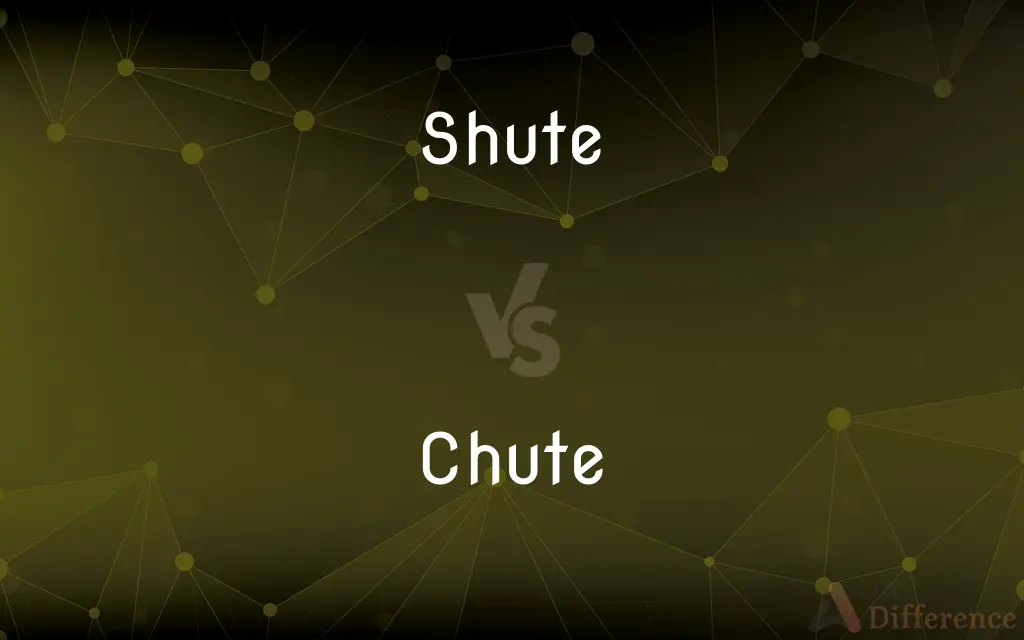Shute vs. Chute — What's the Difference?
By Fiza Rafique & Urooj Arif — Updated on March 22, 2024
A shute is an inclined plane or slope used for facilitating the downward movement of materials, while a chute is a tube or trough for sliding objects, emphasizing controlled movement.

Difference Between Shute and Chute
Table of Contents
ADVERTISEMENT
Key Differences
Shutes are engineering solutions often seen in construction and manufacturing, where gravity is used to move objects or materials from a higher to a lower point efficiently. Whereas chutes are designed specifically to guide and control the descent of objects, ensuring they reach their destination safely and in an orderly manner.
While both shutes and chutes utilize gravity to aid in the movement of materials or objects, the design and application of a shute are typically more open and less controlled compared to a chute. Chutes, on the other hand, are characterized by their enclosed or semi-enclosed structures, providing a more directed and secure path for objects to travel down.
In historical contexts, the term "shute" has been used interchangeably with "chute," but modern usage tends to differentiate the two based on their design and function. Shutes are more about the simple act of moving down an inclined plane, while chutes focus on the controlled delivery of items.
The selection between a shute and a chute depends on the specific needs of the application, including the size and nature of the materials being moved, the importance of controlling their descent, and the space available for installation. Chutes often include features such as gates, curves, and soft landings to further control and manage the movement.
Despite their differences, both shutes and chutes play crucial roles in various industries, from construction and mining to logistics and waste management, showcasing the diverse ways in which gravity can be harnessed to facilitate movement and improve efficiency.
ADVERTISEMENT
Comparison Chart
Design
Inclined plane or slope.
Tube or trough.
Control
Less controlled movement, more open.
Controlled descent, often enclosed.
Application
Used in construction, manufacturing for moving materials.
Used to guide objects safely, found in various industries.
Enclosure
Typically open.
Enclosed or semi-enclosed.
Movement
Facilitates downward movement using gravity.
Ensures orderly and safe delivery.
Compare with Definitions
Shute
Less focused on controlling the descent, allowing for a broader range of materials.
The shute at the quarry allowed for rapid movement of rubble.
Chute
Prioritizes orderly delivery and safety over simple efficiency.
The emergency escape chute is designed for quick, safe evacuations.
Shute
Can be temporary or permanent, depending on the application.
A temporary wooden shute was constructed for the demolition project.
Chute
Enclosed to prevent spillage and ensure safety.
The playground slide is a type of chute, ensuring a safe landing for children.
Shute
Simplicity in design, making it versatile for various industries.
Farmers often use shutes for moving grain in silos.
Chute
Used in a wide range of industries, including logistics and waste management.
The recycling plant used chutes to sort materials into different bins.
Shute
An inclined plane facilitating the movement of materials downwards.
The construction crew used a shute to transport bricks to the lower levels.
Chute
Features may include gates or curves for additional control.
The mail chute in the building had a curved bottom to slow down the parcels.
Shute
Often used in situations where speed and efficiency are prioritized.
The shute greatly increased the speed of loading materials onto trucks.
Chute
A tube or trough designed for the controlled descent of objects.
The laundry chute directed clothes straight to the basement.
Shute
Alternative form of chute
Chute
A sloping channel or slide for conveying things to a lower level
Cement was loaded on to barges via chutes
Shute
Alternative form of shoot
Chute
A narrow metal enclosure for holding or restraining livestock, in which an animal may be vaccinated, branded, etc.
Cattle tend to be calmer in a chute with solid sides
Shute
A steep road through a cleft in a hill.
Chute
A parachute.
Shute
Same as Chute, or Shoot.
Chute
An inclined trough, passage, or channel through or down which things may pass.
Shute
English writer who settled in Norway after World War II (1899-1960)
Chute
A narrow, usually fenced passage for horses or cattle.
Chute
A usually straight extension of one side of an oval racetrack, used to start certain longer races so that the finish line can be kept on a straightaway in front of the stands or clubhouse.
Chute
A gated stall that is used to hold and release animals into an open area, especially horses and steers being ridden in a rodeo.
Chute
A waterfall or rapid.
Chute
A parachute.
Chute
To convey or deposit by a chute.
Chute
To go or descend by a chute.
Chute
A framework, trough, or tube, upon or through which objects are made to slide from a higher to a lower level, or through which water passes to a wheel.
Chute
A waterfall or rapid.
Chute
The pen in which an animal is confined before being released in a rodeo.
Chute
(informal) A parachute.
Chute
A spinnaker.
Chute
To parachute.
Chute
A framework, trough, or tube, upon or through which objects are made to slide from a higher to a lower level, or through which water passes to a wheel.
Chute
See Shoot.
Chute
Rescue equipment consisting of a device that fills with air and retards your fall
Chute
Sloping channel through which things can descend
Common Curiosities
What is a shute used for?
A shute is used for efficiently moving materials downward using an inclined plane.
What industries use chutes?
Chutes are used across various industries, including construction, waste management, logistics, and amusement parks.
How does a chute differ from a shute?
A chute is specifically designed as a tube or trough to control the descent of objects, often being enclosed.
Can shutes be used for people?
While not designed for people, in some emergency situations, improvised shutes have been used for evacuation.
Why would someone choose a shute over a chute?
A shute might be chosen for its simplicity and efficiency in situations where controlled descent is less critical.
Are chutes safer than shutes?
Generally, chutes are considered safer for controlling the descent of objects due to their enclosed design.
What factors influence the design of a chute?
Factors include the type of material or objects being moved, the need for control in the descent, safety requirements, and space constraints.
Is there a difference in the materials used for shutes and chutes?
The materials can vary based on the specific application, though chutes often require durable, smooth materials to minimize friction and wear.
What's the significance of a chute being enclosed?
Enclosure in a chute helps prevent objects from falling out, ensuring a safer and cleaner operation.
Can a chute be used for emergency evacuations?
Yes, specially designed emergency escape chutes are used in buildings and aircraft for rapid evacuations.
Can chutes have curves?
Yes, chutes can include curves, gates, and other features to manage speed and direction.
How are shutes constructed?
Shutes can be made from various materials, including wood, metal, or concrete, depending on the application.
Do chutes require maintenance?
Yes, chutes require regular maintenance to ensure they remain safe and effective for use.
How do gravity and design affect the function of shutes and chutes?
Both rely on gravity for movement; however, the design of chutes focuses on controlling descent, while shutes may allow more free-flowing movement.
How does the application of shutes and chutes differ in the construction industry?
In construction, shutes might be used for removing debris, while chutes could be used for delivering materials to specific locations with more control.
Share Your Discovery

Previous Comparison
Allotted vs. Allocate
Next Comparison
Bend vs. SagAuthor Spotlight
Written by
Fiza RafiqueFiza Rafique is a skilled content writer at AskDifference.com, where she meticulously refines and enhances written pieces. Drawing from her vast editorial expertise, Fiza ensures clarity, accuracy, and precision in every article. Passionate about language, she continually seeks to elevate the quality of content for readers worldwide.
Co-written by
Urooj ArifUrooj is a skilled content writer at Ask Difference, known for her exceptional ability to simplify complex topics into engaging and informative content. With a passion for research and a flair for clear, concise writing, she consistently delivers articles that resonate with our diverse audience.
















































